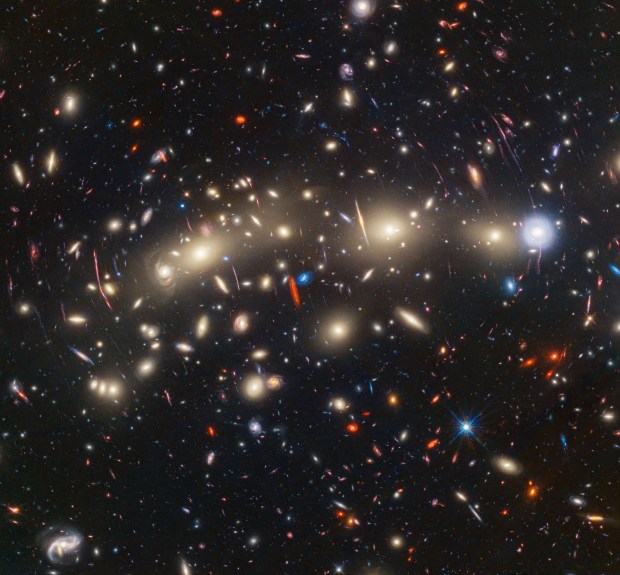
A vibrant and shimmering new image of a massive galaxy cluster is dazzling astronomers. By combining the James Webb Telescope’s (JWST) infrared sight with the Hubble Space Telescope’s (HST) optical deep-field views of the universe, scientists have constructed the most colorful panorama of the MACS0416 galaxy cluster to date.
The glitzy cluster, dubbed the Christmas Tree Galaxy Cluster, is 4.3 billion light-years from Earth and consists of two merging galaxy clusters. Eventually the two groups will combine to form one larger cluster. The image reveals not only the cluster’s core, but also galaxies residing outside the cluster as well as transient objects that appear bright for a short period of time before disappearing. Researchers suspect that two of 14 identified transients may be supernovae. The other 12 appear to be individual stars in three different galaxies magnified by gravitational lensing, which occurs when a massive object (such as a cluster) passes in front of a more distant background object, such as these three galaxies. The foreground cluster acts as a magnifying glass, temporarily brightening and enlarging features in the more distant background source.
Details about the transients objects have been accepted for publication in the Astrophysical Journal and are currently available on the arXiv preprint server.
“We’re calling MACS0416 the Christmas Tree Galaxy Cluster, both because it’s so colorful and because of the flickering lights we find within it,” said study lead author Haojing Yan of the University of Missouri in a press release. “We can see so many transients in certain regions of this area because of a phenomenon known as gravitational lensing, which is magnifying galaxies behind this cluster.”
Flickering lights
HST first observed the MACS0416, also called MACS J0416.1−2403, in 2014 as part of the Frontier Fields project, which used galaxies as a giant magnifying lenses to see even more distant galaxies too far for Hubble to see on its own. Now, JWST has taken the effort one step further by adding its infrared eye, resulting in 12 new transient objects. The team identified the new set by comparing four different epochs of JWST images of the cluster to look for “lights” that appeared and disappeared over the course of 126 days.
“These transient objects appear bright for only a short period of time and then are gone; it’s like we’re peering through a shifting magnifying glass,” Yan said. “Right now, we have this rare chance that nature has given us to get a detailed view of individual stars that are located very far away. While we are currently only able to see the brightest ones, if we do this long enough — and frequently enough — we will be able to determine how many bright stars there are, and how massive they are.”
Estimating distance with color
In this composite image, the shortest wavelengths of light appear in blue. The longest wavelengths are red, and those in between are green. The resulting image is the most colorful view of the cluster to date. The colors also tell researchers how far an object is. Bluer galaxies are closer and show the most star formation, as gleaned by Hubble. Red galaxies tend to be farther away and can only be seen by JWST. However, some galaxies can also appear red because of the amount of dust they contain, as dust absorbs bluer wavelengths of light, letting only the red through.
Mothra: A monster star system

Among the transients, one stood out from all the rest. Dubbed Mothra for its “monster” nature as a bright and highly magnified point of light, the star system resides in a galaxy viewed about 3 billion years after the Big Bang.
We see Mothra magnified by about 4,000x. Interestingly, Mothra also made an appearance in the previous HST images, meaning that whatever object within MACS0416 that is acting as a magnifying glass to show us Mothra hasn’t moved enough to stop lensing the distant cluster in all this time. The team has determined the mass of the lens is some 10,000 to 1 million times the mass of our Sun, and might be a globular star cluster too faint for Webb to pick out, said astronomer Jose Diego at the Instituto de Física de Cantabri in Spain. Diego is lead author of a paper detailing Mothra, which was published Nov. 1 in Astronomy & Astrophysics.
